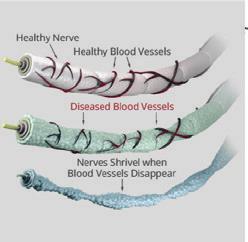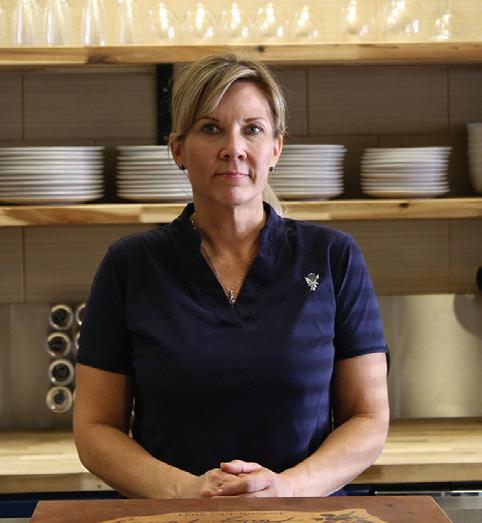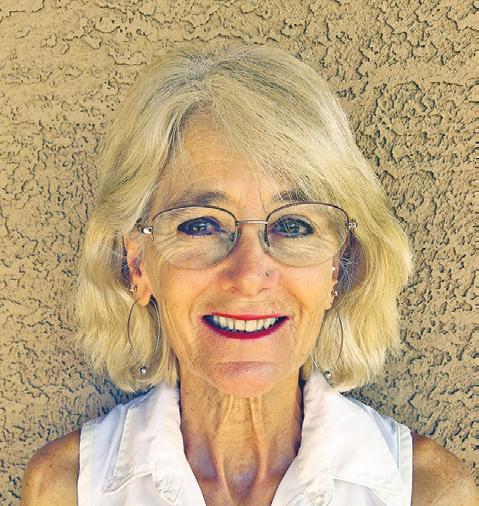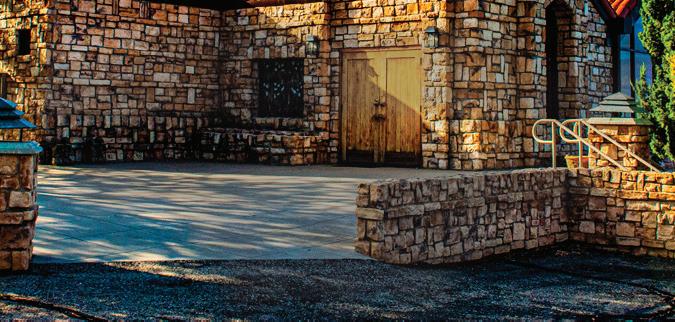INSIDE INSIDE
Marana chef writes recipes for revenge | Page 10
Get a happiness boost at Antsy Nancy | Page 12
Thrive and Grow Farms tour shares regenerative farming methods | Page 13

www.tucsonlocalmedia.com

Marana chef writes recipes for revenge | Page 10
Get a happiness boost at Antsy Nancy | Page 12
Thrive and Grow Farms tour shares regenerative farming methods | Page 13

www.tucsonlocalmedia.com
ean Fedigan opened a shelter in a small house for women experiencing homelessness, believing it would be sufficient to aid the crisis in 2009. As the guest numbers increased, she was surprised.
“We see few on the street, but there are many, many more that remain hidden, abused, frightened and hungry,” Fedigan
said. “That to me is unconscionable, we should not let any of it happen to anyone.”
Fedigan is the founder of the Sister José Women’s Center and has spent 14 years maintaining it for women throughout the city. At 75 years old, she said it’s time to pass the torch and step into a new role as chief mission officer, allowing her to be more present within the center. Previous chief operating officer Nicola Hartmann will be the nonprofit’s second chief execu-
tive officer.
Hartmann has worked for The Sister José Women’s Center for a year and a half and understood the importance of continuing Fedigan’s mission. This year alone, the nonprofit has seen a 42% increase in the women it serves, many displaced through eviction and rising rent. It’s a number Hartmann noted with a mix of pride and
See SISTER JOSÉ Page 6
Petty Officer 3rd Class Aaron Sisk, a native of Tucson, supports versatile missions while serving at Helicopter Mine Countermeasures Squadron (HM) 12.
Sisk joined the Navy two years ago. Today, Sisk serves as a yeoman.
“I joined the Navy to explore career opportunities and find new direction,” Sisk said.
Sisk attended Sahuarita High School and graduated in 2020.
Skills and values similar to those found in Tucson led to success in the military.
“I learned to do my best at everything regardless of how I feel about the task at hand,” Sisk said.
These lessons have helped Sisk while serving with the Navy.
Members of HM 12 fly and maintain helicopters for the U.S. Navy. Navy helicopters

are able to perform many different missions. In general, some of the most common operations include search and rescue, air assaults, medical evacuations, supply transport and hunting submarines.
This year commemorates 50 years of women flying in the U.S. Navy. In 1973, the first eight women began flight school in Pensacola; one year later six of them, known as “The First Six,” earned their “Wings of Gold.” Over the past 50 years, the Navy has expanded its roles for women to lead and serve globally and today our women aviators project power from the sea in every type of Navy, Marine Corps, and Coast Guard aircraft.
As a member of the Navy, Sisk is part of a world-class organization focused on maintaining maritime dominance, strengthening partnerships, increasing competitive warfighting capabilities and sustaining com-
See NAVY Page 8


Tucson native Petty Officer 3rd Class Aaron Sisk is grateful for all the friends he’s made in the Navy. (Chief Mass Communication Specialist Terah Bryant, Navy Office of Community Outreach/Submitted)




DYLAN SCOTT
MAY 19th • SHOW 8:00PM
MAY 20th • 4PM - 11PM






AMBROSIA & FIREFALL
JUNE 3rd • SHOW 8:00PM
JUNE 30th • SHOW 8:00PM
GRAND FUNK RAILROAD JULY 22nd • SHOW 8:00PM GIPSY KINGS
AUGUST 5th • SHOW 8:00PM

Tucson, AZ - When it comes to chronic pain and/ or neuropathy, the most common doctor-prescribed treatment is drugs like Gabapentin, Lyrica, Cymbalta, and Neurontin. The problem with anti-depressants or anti-seizure medications like these is that they offer purely symptomatic relief, as opposed to targeting and treating the root of the problem. Worse, these drugs often trigger an onset of uncomfortable, painful, and sometimes harmful side effects.
(above 95% nerve loss is rarely treatable)
3. The amount of treatment required for the patient’s unique condition
Arrowhead Physical Medicine in Tuscon, AZ uses a state-of-the-art electric cell signaling systems worth $100,000.00. This ground-breaking treatment is engineered to achieve the following, accompanied by advanced diagnostics and a basic skin biopsy to accurately analyze results:


The only way to effectively treat chronic pain and/or peripheral neuropathy is by targeting the source, which is the result of nerve damage owing to inadequate blood flow to the nerves in the hands and feet. This often causes weakness and numbness.

As displayed in figure 1 above, the nerves are surrounded by diseased, withered blood vessels. A lack of sufficient nutrients means the nerves cannot survive, and thus, slowly die. This leads to those painful and frustrating consequences we were talking about earlier, like weakness, numbness, tingling, balance issues, and perhaps even a burning sensation.
The drugs your doctor might prescribe will temporarily conceal the problems, putting a “BandAid” over a situation that will only continue to deteriorate without further action.
1. Increases blood flow
2. Stimulates and strengthens small fiber nerves
3. Improves brain-based pain
The treatment works by delivering energy to the affected area(s) at varying wavelengths, from low- to middle-frequency signals, while also using Amplitude Modulated (AM) and Frequency Modulated (FM) signaling.
It’s completely painless!
THE GREAT NEWS IS THAT THIS TREATMENT IS COVERED BY MEDICARE, MEDICAID, AND MOST INSURANCES!!
Depending on your coverage, your peripheral neuropathy treatment could cost almost nothing – or be absolutely free.
The number of treatments required varies from patient to patient, and can only be determined following an in-depth neurological and vascular examination. As long as you have less them 95% nerve damage, there is hope!

Thankfully, Tuscon is the birthplace of a brand new facility that sheds light on this pressing problem of peripheral neuropathy and chronic pain. The company is trailblazing the medical industry by replacing outdated drugs and symptomatic reprieves with an advanced machine that targets the root of the problem at hand.
Effective neuropathy treatment relies on the following three factors:
1. Finding the underlying cause
2. Determining the extent of the nerve damage

Arrowhead Physical Medicine begins by analyzing the extent of the nerve damage – a complimentary service for your friends and family. Each exam comprises a detailed sensory evaluation, extensive peripheral vascular testing, and comprehensive analysis of neuropathy findings.
Arrowhead Physical Medicine will be offering this free chronic pain and neuropathy severity evaluation will be available until May 31st, 2023. Call (520) 934-0130 to make an appointment.
Due to our very busy office schedule, we are limiting this offer to the first 10 callers. YOU DO NOT HAVE TO SUFFER ANOTHER MINUTE, CALL (520) 934-0130...NOW!!
We are extremely busy, so we are unavailable, please leave a voice message and we will get back to you as soon as possible.
The Foothills News is published twice each month and distributed free of charge to homes and in single-copy locations throughout the Catalina Foothills. STAFF
ADMINISTRATION
Steve T. Strickbine, Publisher
Michael Hiatt, Vice President
Claudine Sowards, Accounting claudine@timeslocalmedia.com
EDITORIAL
Christina Fuoco-Karasinski, Executive Editor christina@timeslocalmedia.com
Karen Scha ner, Sta Reporter kscha ner@tucsonlocalmedia.com
Veronica Ku el, Sta Reporter vku el@tucsonlocalmedia.com
PRODUCTION
Courtney Oldham, Design Manager production@timeslocalmedia.com
Veronica Thurman, Graphic Designer vthurman@timeslocalmedia.com
CIRCULATION
Aaron Kolodny, Circulation Director aaron@phoenix.org
Brian Juhl, Distribution Manager brian@timeslocalmedia.com
ADVERTISING
TLMSales@TucsonLocalMedia.com
Kristin Chester, Account Executive kristin@tucsonlocalmedia.com
Candace Murray, Account Executive candace@tucsonlocalmedia.com
Tyler Vondrak, Account Executive tyler@tucsonlocalmedia.com
NATIONAL ADVERTISING
Zac Reynolds, Director of National Advertising Zac@timeslocalmedia.com


















































ROC#032524

 BY CHRISTINA FUOCO-KARASINSKI Tucson Local Media Staff
BY CHRISTINA FUOCO-KARASINSKI Tucson Local Media Staff
The African American Museum of Southern Arizona has opened its doors at the UA. Co-founded by Beverly and Bob Elliott, the museum presents a cultural and educational experience through items of significance and intentional storytelling to preserve African American and Black life, culture and history in Southern Arizona to benefit the community. Admission is free to the museum in room 244 of the Student Union Memorial Center. Until regular hours are established, interested visitors can schedule an appointment by emailing aamuseumofsouthernaz@gmail.com.
African American Museum of Southern Arizona, 4511 N. Campbell Avenue, Suite 255-2, Tucson, free, by appointment only, aamsaz.org
The Spring 2023 Annual Juried Student Award Art Exhibition, hosted by the Louis Carlos Bernal Gallery, brings together the best student artwork for the summer, fall and spring semesters from any student taught at the five campuses at Pima Community College. The 237 entries were received from 104 students, and 77 entries were accepted by the jurors for this exhibition. This year, the Bernal Gallery has Tucson Art Museum staff as jurors who choose the students and award winners. The jurors were Dr. Julie Sasse, chief curator of modern and contemporary art, Tucson Museum of Art (TMA); Olivia Miller, interim director and curator, University of Arizona Museum of Art (UAMA); and Harrison Orr, education director, Museum of Contemporary Art (MOCA-Tucson). The reception is 3 to 5 p.m. Thursday, April 20; award ceremony at 4 p.m.
Louis Carlos Bernal Gallery, Center for the Arts -West Campus, 2202 W. Anklam Road, free, various times, 520-206-6942, pima.edu/cfa-gallery
Willem de Koonig’s “Woman-Ochre” was stolen in 1985 from the University of Arizona Museum of Art. It’s returned home and on display through May. Tickets for “Restored: The Return of Woman-Ochre” are $8 general admission; $6 seniors 65plus and groups of 10 or more; and free for students with ID, museum members, UA faculty, staff, military personnel, AAM members, visitors with a SNAP card or Tribal ID, and children.
The University of Arizona Museum of Art, 1031 N. Olive Road, Tucson, various pricing, artmuseum.arizona.edu
Linda McCartney Retrospective TO AUGUST 4
The North American premiere of the Linda McCartney Retrospective comes to the University of Arizona Center for Creative Photography, now through Friday, Aug. 4. Spanning McCartney’s entire career from 1965 to 1997, this exhibition features 176 photographs and archival materials, including Polaroid images and presents three sections such as family life, photographic experimentation and artists. The exhibit will recur weekly from Tuesdays through Saturdays, from 10 a.m. to 4:30 p.m. The exhibition will also feature various community events inspired by the collection.
Center for Creative Photography 1030 N. Olive Road, Tucson, various times and pricing, ccp.arizona.edu
Mini Time Museum: Steve Farley’s “Dowdytown” TO AUG. 20
Pandemic isolation inspired artist, graphic designer and former Arizona State Sen. Steve Farley to explore childhood memories through a series of miniatures. They’re artifacts of his Ontario, California home, but their resonance with childhood reveries is universal. Farley’s youth included a fondness for building miniature models. As an adult, he’s an artist and graphic designer renowned for public murals. He found that creating these tiny
As far as current interior design trends go, maximalism is bigger than ever. New textiles are a game-changer, retro is popular (again), and we all want a lighter environmental footprint. This concise overview is courtesy of Marisela Panzarella, the Designer/Move-In Coordinator at Splendido, an all-inclusive community in Oro Valley for those 55 and better. When residents first move to Splendido, Marisela helps them with space planning and design. She also lends her expertise in the community’s amenity spaces— including newly transformed restaurants.
Maximalism still going strong. While midcentury modern furniture is here to stay for a while, the maximalist trend of opulent, lush décor featuring layers of sumptuous textures has grown in popu-
larity. Instead of clearing out a lot of your older pieces, Marisela says the new trend seems to be, “If it gives you joy, keep it—only make it bright, to bring happiness in!” She says that those who pre-
fer minimalism can keep their pared-down décor, but have fun incorporating a bit of maximalism with a single grouping of small items on a mantel or side table, or a short wall devoted to an eclec-
tic art collection.
High-performance fabrics changed everything. Manufacturers are creating upholstery and other fabrics that look like velvet and linen but



can withstand a lot of wear and tear. So you can have a white sofa, for example, without worrying about how it will hold up. The variety is amazing— even faux-distressed fabrics—and you can layer them for that maximalist look. “We used these in Splendido’s restaurants— it wouldn’t have been possible to use real linen on chairs that get that much use,” says Marisela. “And unlike older manufactured fabric, these are soft and comfortable.”
The 70s are back! Designers are having fun with 1970s colors and patterns. “I see a lot of retro earth tones, especially browns and golds, paired with deep blue, and geometric and basketweave patterns,” says Marisela.
Reduce, reuse, recycle.
A lighter environmental footprint is important to people today, so it’s “in” to use recycled and repurposed furniture.
“Hold onto the furniture that’s meaningful to you,” Marisela says. “Those pieces can be used as accents to your new decor. Think beyond painting—you can reupholster chairs or sofas, change out chair or table legs, and updatehardware on drawers.”
While these trends are fun and offer diverse options, Marisela stresses that, “You are not obligated to follow any trends. Your home should be a reflection of who you are and what makes you happy.”
You can learn more about design trends, and get expert advice on downsizing for a move or makeover, at Splendido’s Downsizing & Design Tips event on Wednesday, May 10 at 10:00 a.m. All are welcome, but RSVPs are required. Visit splendidotucson.com/events to register online, or call (520) 878.2612.







Ultimately, it’s your experience
We do everything with that idea clearly in mind. So, go ahead, enjoy yourself with great social opportunities and amenities. Savor fine dining every day. And feel assured that assisted living services are always available if needed. We invite you to experience Villa Hermosa at our upcoming event.
Mother’s Day Fashion Show & Tea
THURSDAY, MAY 11TH • 11:00AM Join us to see the latest trends in apparel. Shop spring fashions & accessories while enjoying flavored hot teas accompanied by a delicious array of light refreshments To RSVP, call 520.704.6497.

HOT PICKS from Page 4
structures helped to ground him in the social and emotional upheaval that accompanied our months in lockdown. An artist reception and talk take place from 10 a.m. to noon Saturday, April 22.
Mini Time Machine Museum of Miniatures, 4455 E. Camp Lowell Drive, tickets start at $8, 9 a.m. to 4 p.m. Tuesdays to Thursdays, theminitimemachine.org
Kuumba In Afrikan Arts
MAY 13
For more than a decade, Barbea Williams Performing Company has offered this fiveweek camp experience for children ages 7 through 15. The program covers West African Dance, African diaspora culture and art, drumming, healthy cooking and beauty. For the first time this year, the program also includes STEM programming in professional development workshops.
Register now via bwpcarizona.com, class starts at 2 p.m., email bwpc2020@ gmail.com for details, $1,200, discounts and scholarships available.
Western Experience TO MAY 7
Journey into a Western Experience at Old Tucson Studios, through Sunday, May 7, and witness the spirit of the Old West come alive. Get a glimpse of a historic town in Arizona territory during the 1800s and enjoy live action cowboy gun fights, death defying stunts, rides and attractions.
Old Tucson Studios, 201 S. Kinney Road,
JOSÉ from Page 1
devastation; more people served at the center means more underserved by the community.
“Homeless women are hidden on our streets, and we get to know them because we see them,” Hartmann said. “I wanted to be part of how we could continue to serve them, to honor Jean’s legacy but to keep taking the organization to the next level.”
Fedigan’s new position will connect her more closely with the center’s guests and the community. The position will be part-time and allow Fedigan to connect with organizations and agencies for broader outreach.
Tucson, $34 adults, $17 children ages 5 to 11, 10:30 a.m. to 5 p.m. Thursdays to Sundays, oldtucson.com
Kentucky Derby Watch Party MAY 6
The Rillito Park Foundation invites us to celebrate the Kentucky Derby almost as if we’re right there at Churchill Downs. There will be live betting and Mint Juleps plus food, beverages, a raffle, prizes and a souvenir for the first 100 guests. Attendees are encouraged to “dress to impress.” Churchill Downs may be more famous, but Rillito Park is known as “The birthplace of modern Quarter Horse racing.” Rillito Park Racetrack, 4502 N. First Avenue, free, noon to 5 p.m., rillitoracetrack. com
Cinco de Mayo at Hotel Congress MAY 5 AND MAY 6
Roger Clyne and the Peacemakers is a Sonoran Desert band and happy to be. Fans in Arizona and Mexico flock to their shows, which often sell out, to revel in their distinctive blend of desert folk and pop rock, layered with road dust, shimmering hot sand and the light of starry nights. They perform on the plaza at 6 p.m. Friday, May 5, and will play a completely different set on Saturday, May 6. Meanwhile, in Club Congress, Santa Pachita and Salvador Duran perform on Friday at 8 p.m., and XIXA plays on Saturday at 7 p.m.
Hotel Congress, 311 E. Congress Street, various prices and times, hotelcongress. com
In her time as CEO, Fedigan grew the women’s center to a staff of 30 and expanded their offerings to 42 overnight guests and up to 70 during the day. She spread her message of kindness and understanding, especially to those on the margins of society. Hartmann intends to continue this work and dedication while growing the center and its services.
“She’s very good with business and a woman of integrity and faith, and she has the heart,” Fedigan noted. “You cannot work with a population that needs so much without the heart to do it. She See SISTER JOSÉ Page 8


































SISTER JOSÉ from Page 6
relies on that heart to allow herself to reach out and understand, to touch and work with the women.”
Hartman plans to add 15 beds to the center, along with spaces to include more services to guests. She noted nights when they had to turn people away because the women’s center could not house them and how hard it was in the winter.
As their numbers continue to increase, the two leaders understand the center will need to grow with it. Hartmann stated her predecessor’s legacy is always at the front of her mind during any major decisions. If the women’s center cannot provide compassion and care to all of its guests, its work is incomplete.

“What Jean created was the center of love, and none of this would be here without her tenacity and determination,” Hartmann said. “Every woman who comes in is treated with dignity and respect. Whenever I think about the growth and things we have to do, I keep that in mind.”






Named in honor of Sister José Hobday, the center was created by Fedigan to carry on the Franciscan nun’s ded-







ication to help the poor and vulnerable. In 14 years and counting, she has helped thousands of displaced women in the greater Tucson area.
“I have an absolute belief that com-
NAVY from Page 1
bat-ready forces in support of the National Defense Strategy.
“The Navy has a huge presence at sea to secure the maritime trade lines and deter threats against the United States and its allies,” Sisk said.
With 90% of global commerce traveling by sea and access to the internet relying on the security of undersea fiber optic cables, Navy officials continue to emphasize that the prosperity of the United States is directly linked to trained sailors and a strong Navy.
“Our mission remains timeless - to provide our fellow citizens with nothing less than the very best Navy: fully combat ready at all times, focused on warfighting excellence, and committed to superior leadership at every single level,” said Adm. Mike Gilday, chief of Naval Operations. “This is our calling. And I cannot
munity makes a difference in how we help one another,” Fedigan said. “Until we stand with these people, with these women, and listen to them, then we will always have homelessness.”
imagine a calling more worthy.”
Sisk and the sailors they serve with have many opportunities to achieve accomplishments during their military service.
“I’m proud to have been promoted to petty officer third class last July,” said Sisk. “Taking on more responsibility makes me proud.”
As Sisk and other sailors continue to train and perform missions, they take pride in serving their country in the U.S. Navy.
“To me, serving in the Navy means job security,” Sisk said. “I can count on a good future in the Navy, no matter the economic situation.”
Sisk is grateful to others for helping make a Navy career possible.
“I’m grateful for all the friends I’ve made in the Navy,” Sisk added. “Serving with them makes being away from home feel like home.”

On one of his farm tours, Michael Ismail bent down to check on a rainbow cactus starting to bloom. He explained there weren’t many when he moved to the property, but after implementing his water basin system, native plants have popped up all around and created a desert oasis. He pointed to the string of small pits along the watershed, connecting down to the farm.
“By doing this all around the property, you essentially create this lens of water in the ground,” Ismail said. “It moves down the slope and ends up benefitting the ecosystem all the way down.”
Ismail and his team at Thrive and Grow Farms host tours at their property in Vail to teach about regenerative farming. Neighboring Cienega Creek Preserve, this farm will soon be a demonstration of its new business model, where they develop land to prioritize a regenerative ecosystem and sell the final product to farmers. Ismail calls their new model turnkey farming. Ismail is an agricultural entrepreneur, expert and educator with a focus on land conservation. He was raised in a homestead near Tucson, where his family turned a patch of desert into a thriving farm.
“I grew up growing a lot of food and learning permaculture practices,” Ismail recalled. “My father taught me land development methods through a lot of passive rainwater retention. We were very mindful of the way we existed in our little ecosystem.”
As an adult, he noticed most people believed they had “brown thumbs” and couldn’t care for plants, let alone gardens or farms. Ismail decided to use his knowledge and experience to create the Thrive and Grow brand. The company’s goal is to develop a stronger, local regenerative food system, developing land and infrastructure for farmers to walk into and succeed.
Ismail defined regenerative farming as a practice that goes beyond sustainability, it’s farming the land the way nature does. It focuses on the health of the soil and the conservation of resources, eliminating harmful traditional methods like tillage. Especially in the desert, the priority is water retention, and he develops each farm based on water flow and keeping it in the ground. His system not only focuses on conservation tactics but limits the amount of water used in overall farming.
“Agriculture is one of the largest uses of water throughout Arizona,” Ismail said. “The fact that we can put more water into the ground with our demon-
stration than we take out is a really important step.”
Their turnkey farming project is in its initial stages of funding. Through WeFunder, Thrive and Grow Farms has raised over $125,000 to develop its properties and continues to receive support.
As Ismail and his team receive money, they will develop their 32 acres in St. David into four turnkey farms. Once the farms are complete, they hope to sell each within six months. Ismail stressed the importance of developing the land and infrastructure to make it easy for farmers to conduct their business.
“We wanted to ensure people could walk into this and have a bright future in agriculture,” Ismail said. “It’s important to have a solid business plan and to know what to expect with all of the procedures in farming.”
Along with providing the land, Thrive and Grow Farms will also include their connections with local food markets and key business infrastructure. Any extra crops may be sold to the company to be freeze-dried, which will prevent spoilage and optimize sales for farmers. The company will sell the food under its new food brand, Truly Regenerative.
Ismail foreshadowed an upcoming trend toward regeneratively farmed products, much like the craze for or-
ganic foods. His mission is to help farmers see the value of these practices, not only to meet public demand but to create long-term profitability.
“One thing I believe is a common misconception is to do things right, you have to sacrifice a profitable business,” Ismail said. “We’re actually finding that it’s the opposite. These methods can create more stability for farmers and a better product for consumers.”
He noted the power of regenerative farming and its impact on the land. Along with examples of improved crop growth, Ismail’s demonstration farm is flourishing with a variety of native plants and animals.
Though in its initial stages, Thrive and Grow Farms is an opportunity for people to see the long-term benefits of regenerative agriculture, especially in a drought-prone environment. Ismail encourages those interested in recentering their business or starting new to come out for a tour and see the impact in person.
“It’s scary for a farmer to make changes and create any sort of uncertainty with growing crops and providing for their families,” Ismail said. “By demonstrating some of these practices, we can show people it’s very possible. They can create more resilient businesses while using less water.”







































































Although his new book, “Cookbook for Revenge,” contains autobiographical details, Chef Gilbert-Alan Sanchez wants his readers to know he is not a serial killer.
That’s not to say that he hasn’t seen chefs purposely burn their servers’ hands by handing them a hot plate, or other cruelties inflicted by head chefs on to their staff or hapless visitors who unintentionally wander into a restaurant’s kitchen.
“When I was coming up in the business, it wasn’t a very nice business,” Sanchez said.
“People did whatever they wanted, and they got away with it. There were no HR directors. There was nobody around that could stop some of these guys from doing what they were doing because it was always, ‘Well, you know, he’s the chef. You know how the chef is.’”
“It was very helpful getting it all out on the pages. It was therapeutic. Somebody at the (Tucson Book Festival) was telling me, ‘Sometimes you just have to let it go.’ I said, ‘I did; I did let it go on the pages of the book.’”
Today, Sanchez is head chef at the White Stallion Ranch, a guest ranch located down a long dirt Marana road in the foothills of the White Mountains. He is not, he said, like the chefs you will find in his first-time novel, or anywhere else for that matter.
He admitted he’s seen plenty, and much


of it has left its mark on him, including a couple of bouts with cancer.
Writing “Cookbook for Revenge,” a fictional story about two people who exact revenge on their former bosses, has helped Sanchez heal. He said he’s exorcized at least some of those demons.
“It was very helpful getting it all out on the pages,” he said. “It was therapeutic. Somebody at the (Tucson Book Festival) was telling me, ‘Sometimes you just have to let it go.’ I said, ‘I did; I did let it go on the pages of the book.’”
Reactions to the story have been mixed. Some, Sanchez said, loved it. Other readers have asked him if he is promoting revenge.
“I’m not promoting revenge,” he said. “I’m just telling my story of some of the things that happened to me along with adding more to the story. Not everything was true but just getting out what I needed to get out, it helped me.”
Getting the book to press was a family affair. Cover art, featuring a stylized bloody hand holding a knife-like carrot, was designed by his 14-year-old daughter, who is not allowed to read the novel. His adult son was his editor.
Sanchez began his restaurant career busing tables at age 14. Washing dishes was soon tacked on to his duties. Finally, his boss told him he could be in front of the house or in back. He chose back. Now at 60, he finds he loves to cook.
“To me, it’s an artform,” he said. “It’s a passion, making the person who is eating the food, making them happy is something that makes me feel good inside.”
In addition, he loves where he works.
“At 60 years old, I’m in a much happier spot working in this place than I’ve ever been, than I probably have been in my entire career,” Sanchez said.
Plus, he has a great crew, and it makes for a much nicer work environment. He reflected on the way he interacts with his employees now, instead of 20 years ago, when he had been trained to abuse his staff.
“The staff that I have now, we all joke, we all laugh,” Sanchez said. “I don’t scream, I don’t yell. There are no off-color jokes. There’s no cussing. I try to create a family type of an atmosphere where we’re all joking. For the most part, the atmosphere that I can create is way different than what I grew up in.”
Sanchez liked writing this first novel so much he’s working on a sequel. No release date for that one yet, but he said he’s hoping it will be ready a year from now.
“Cookbook for Revenge” by Gilbert-Alan Sanchez Amazon: http://bitly.ws/CyG2 Barnes & Noble: http://bitly.ws/CyGB
Audible: http://bitly.ws/CyHm
With the dramatic increase in housing prices, organizations are stepping up to create solutions for Southern Arizona. Habitat for Humanity Tucson recently showcased its new CHUCK Center, a project CEO Charlie Buchanan called a comparable answer to the growing problem.
“This is a crisis we haven’t experienced in generations,” Buchanan said. “It’s not a low-income challenge anymore, it’s an everybody challenge. It’s redefined housing affordability.”
The purpose of the new Connie Hillman Urban Construction Knowledge Center is to support the lack of affordable housing in Greater Tucson and to address the need for a skilled workforce in the trades. Habitat Tucson will be able to prefabricate homes and store materials in a temperature-controlled warehouse. The center will not only accelerate housing production but the education of schools, colleges and other programs in the area.
It’s a development for the nonprofit, and Buchanan noted its potential for increasing work quality within Habitat Tucson.
“We build homes, community and hope,” Buchanan said. “This isn’t anything new to us, but it’s certainly a different scale. The ultimate goal is to provide more housing solutions in a challenging environment.”
The CHUCK Center holds offices, a classroom and a large warehouse. Habitat Tucson will use the space to store tools and materials for projects across the community, including prefabricated panels made in the facility.
A one-story home under 1,500 square feet takes 18 to 26 panels to build, while a two-story of the same size requires 24 to 32. Habitat Tucson plans to build at least 10 panels per day and store up to 144 panels, enough for around five to eight homes, in the CHUCK Center.
Tony Lundberg is an AmeriCorps member with Habitat Tucson, and addressed challenges in the past associated with building these panels and procuring materials.
“It would lag our construction progress,” Lundberg said. “At some point during the

builds we had in Marana, we weren’t able to procure doors or windows, even lumber. It’s beneficial to have a safe, dry indoor spot for all of these sensitive materials.”
The CHUCK Center was primarily funded by the Connie Hillman Family Foundation, along with other organizations and nonprofits like The Stonewall Foundation, Bank of America and the City of Tucson. Its partners contribute to the facility with donations of money but also labor, as is the case with AmeriCorps.
AmeriCorps contributes workers to volunteer with Habitat Tucson projects, one of the options for their member commitment to one year of intensive service. According to Lundberg, most organizations and nonprofits offer housing, but in past years, Habitat Tucson didn’t have the budget for it.
The CHUCK Center is building a duplex house in its backyard to meet the needs of out-of-state AmeriCorps members. Lundberg expressed his relief for future members and their access to this housing.
“The AmeriCorps members receive only a small stipend for their service, making living in Tucson hard for most,” Lundberg said. “It’s very difficult to pay rent and groceries on the stipend, so it’s a necessary means to find affordable or provided living for nonprofits like Habitat.”
Another key part of Habitat Tucson’s commitment with the CHUCK Center is to provide educational resources to assist trade students. The nonprofit has started this by partnering with the Building & Construction Technologies program at
Pima Community College. Lundberg of Tucson’s AmeriCorps team was one of the program’s past students.
Due to current space constraints on campus, BCT Discipline Coordinator Himat Khalsa visits Habitat Tucson with his classes weekly. Pima Community College
works to increase its facilities for the program, but for now, the CHUCK Center allows students to gain real-world experience and make an impact on the community.
“A lot of this has been facilitated through the CHUCK Center because there’s a real training focus,” Khalsa explained. “Here, there are potentially other people from different trades that will interact with the students as we’re building. Those are features that are hard to simulate in a lab environment.”
Khalsa and his students utilize the CHUCK Center to complete varied curriculums, building homes and designing plans which Habitat Tucson puts to use throughout the region. Between the college and nonprofit, their collective goal is to engage 100 student learners in construction trades in 2023.
The partnerships between programs,

Not everything that came out of the pandemic is negative.
Take, for example, Heidi Yribar, whose COVID-19-era brain blast has resulted in a thriving Foothills business.
Want to learn to decorate festive cookies with royal icing? Make pasta and a strawberry panna cotta? A charcuterie board? Maybe guests would rather learn to make a wreath to decorate their home or give their graduate the gift of a lei they’ve made.
For all this knowledge and more, Yribar has you covered.
“I teach people a skill,” she said. “When you leave Antsy Nancy, you’ve actually learned how to do something. I always give everybody the recipes and tell them exactly where to buy the materials so they can try it out here and then decide, ‘Do I like it? Do I want to keep doing it?’”
Located at Craycroft and River roads, Antsy Nancy allows guests to learn a new skill and be able to use it at home. Yribar wants her clients to learn ways to improve home, health and happiness, according to the business’ website. When she opened the business, Yribar expected her clientele would be active retired adults, and they are some of her students. However, she was surprised by the popularity of the children’s classes.


“The kids’ (business) is really huge,” Yribar said. “All the summer camps, winter break camps, spring break, and the parents just love it.”
Besides the camps, which begin in May, she has a once-a-month Kids Night Out, where kids 5 years old to high school age learn to make a themed food dish, then watch a movie. For example, last month the kids made fortune cookies and pot stickers, then watched the Disney’s “Mulan.” This month it’s angel hair pasta from scratch and “Tangled.” All movies come with popcorn. Yribar loves these classes.
“All the kids are so sweet and fun with each other,” she said. “It’s just so neat to watch them try.”
Each class, for adults and children, begins with a provided apron and a locker to store their stuff. Then it’s time to learn.
Naomi and Bianca Fergerson, daughters of Andrea Fergerson, have been going to dinner and a movie since Yribar started them at the beginning of this year. However, this isn’t their first goaround at Antsy Nancy. They’ve been to plenty of activities there. Their continued attendance is testimony to how much fun the workshops are.
“It’s a cute little place; it’s very cozy,” she said, “(and Yribar) has such a variety of activities. The girls get some hands-on

experience.”
It’s also Yribar who makes the workshops fun.
“She is just very, very organized, and she connects so well with the youth, they just cannot get enough,” Fergerson said.
Antsy Nancy is named after Yribar’s aunt, Nancy Rutherford, who is a dap hand at all things baking and craft. It’s where Yribar learned to decorate cookies. It happened this way. In January 2020, Yribar found herself unexpectedly unemployed. She applied for hundreds of positions but couldn’t find traction.
“I was bored out of my mind and then the kids were home,” she said. “I asked my aunt Nancy — she’s an active retiree in Tucson — for pointers on my yard. She came over and it turned into months of us landscaping.”
Yribar does mean landscaping. The pair put in a coy pond.
From there Yribar learned to use her sewing machine, how to recover furniture, do holiday projects, decorate cakes and make wreaths. One day after a marathon cookie decorating session, she was driving home from Rutherford’s home, “and I thought, ‘You know what? There’s a business idea in here,’ and I came up with the idea of Antsy Nancy,” she said. Ten months later she opened her class-
room and she’s been teaching ever since. In fact, Yribar said, in the year and a half she’s been open, she’s making a profit.
“It’s going really, really well,” Yribar said.
The first class on the calendar was how to make an herb garden. No one came. Today she has sellout classes. She also hosts private parties of all types and hires out to teach.
From the outside a casual observer would not guess how elegant the classroom looks. On a recent visit, the room was filled with several bar-high tables covered with white tablecloths and a rose vase, all facing a demonstration kitchen. Yribar said the tables are on wheels and can be rearranged to suit the class. The elegance, she added, is just to make the learning space inviting, like a visit with a very good friend. At least one reaction to the space surprised her.
“My most favorite thing is when a burly man’s man walks in here and says, ‘It’s so cute,’” she said.
More than anything, Yribar wants people to know these classes are for everyone.
“We teach master classes, but they are designed for beginners, and not to shy away from it if they’ve never done it before,” she said.
Sadly, in our country there are still people who suffer from malnutrition or who simply do not get enough to eat daily.
Malnutrition happens when a person does not eat enough of the proper nutrients to maintain good health. There is often an imbalance of daily protein, vitamins, minerals and calories in the diet. It is easy to identify some economically disadvantaged groups such as children who qualify for the free school lunch programs, people who are unhoused, and refugees emigrating from war-torn or brutal environments.
A group less visible and more difficult to identify are our senior citizens. The malnutrition many experience may not be solely related to income but be due to a variety of factors.
Adequate nourishment is critical to good health across the age spectrum, yet many older adults are at risk of inadequate nutrition. Poor nutrition in older adults can lead to many health problems including anemia, fatigue, a weakened immune system, problems with digestion, muscle weakness and falls, and depression.
Many bodily changes that occur with advancing age can affect appetite, taste and how food is absorbed. Approximately 25% of older adults living in their communities will experience some level of malnutrition. The numbers range from 23% to 85% for those in extended care facilities. Malnutrition impacts the health and quality of life at any age but is especially harmful for older adults with less resilience. They can become more vulnerable to falls and hospitalizations. This is a challenging health concern associated with physical decline, illness and increased earlier death.
HABITAT from Page 11

Age alone increases the risk for malnutrition. Chronic illnesses contribute to poor eating habits and poor absorption of nutrients. Aging leads to an increase in body fat and a decrease in muscle mass. This will decrease the metabolic rate which in turns tends to lead to less food intake, even though the nutrient needs remain the same.
Age affects the entire gastrointestinal system. The mouth lining becomes thinner and produces less saliva. Certain medications can make the mouth dryness worse. Tooth decay and loose teeth become more common. We have fewer taste buds as we get older, and the sense of smell becomes less acute so food may become less appealing.
Some medications can cause a decrease in the production of hydrochloric acid in the stomach and this, too, will lead to a poorer absorption of nutrients. The leading cause of malnutrition in the elderly population is the loss of appetite. Pulmonary (lung) diseases and cardiac problems also lead to a loss of appetite and decrease intake while the illnesses themselves require more, not fewer, calories and nutrients.
organizations and the nonprofit will not only create hands-on learning experiences but contribute to Habitat’s goal for universal housing. Here in Southern Arizona, Buchanan and Habitat for Humanity will continue to combat the housing crisis, developing new and innovative solutions to support Tucson.
“The CHUCK Center was our acknowledgment that the status quo wasn’t meeting the need to support the affordable housing crisis,” Buchanan said. “The potential and the partnerships are going to create opportunities for not only trade students and their careers but opportunities for families to have stability.”
Food intake must become more nutrient dense (more bang for the buck!) to meet the increasing metabolic demands of chronic illnesses.
Functional limitations such as an inability to shop or cook can lead to poor eating habits. Dementia may impair everything from cognition and remembering to eat to even a poor ability to swallow.
Social isolation is a major contributor to malnutrition in older adults. Loneliness and a sedentary lifestyle may lead to depression and fatigue, which in turn lead to a reduction in appetite and subsequent poor nutritional status. These lead to increasing weakness, a greater risk for falls, and a decline in mental acuity.
Alcoholism is a problem for many people across the age spectrum but can hit seniors particularly hard. Alcoholism leads to malnutrition by decreasing appetite and frequently becoming a substitute for a meal.
Economic hardship is certainly a cause of malnutrition or under nutrition in any population, including seniors. Food banks and the Commodity Senior Food Program (SCFP) offer surplus foods to those in economic need and the Food Stamps program augments the food budgets of many households.
Mobile Wheels offers low-cost meals delivered to homebound seniors. Supplements such as Ensure and Boost, though excellent, may be cost prohibitive but powdered breakfast drinks added to whole milk can be a flavorful, and less expensive, substitute. Sharing the costs of bulk products, using store coupons, shopping on senior discount days also will help to lower
the costs of groceries.
Family members should assess for weight loss in their elderly relatives. Offer healthy and nutrient dense snacks between meals, such as nut butters on crackers, toast, fruits, and raw vegetables. Whole milk or Greek yogurt with finely chopped nuts, wheat germ, fruit, and granola will boost protein, calcium, and caloric intake.
Making meals more visually appealing and tasty may boost appetite. Restricted diets, such as low salt, do not have to be bland and boring. Experiment with various herbs and spices to make foods tastier and more appealing.
Eating with others, making mealtime a social event, also may stimulate appetite and increase intake. Daily exercise, even if just chair aerobics or a 20-minute walk will boost appetite and increase strength.
A multivitamin and calcium supplement may improve overall nutritional status. Regular physical exams should include height and weight measurements, appropriate blood tests, and diet history. The golden years should not be a time of poor nutrition. Follow up with your health care provider to further explore strategies for optimum nutrition.
Mia Smitt is a longtime nurse practitioner who writes a column for Tucson Local Media.

Medicare rates us a Top Home Health Agency in Arizona
Medicare rates us a Top Home Health Agency in Arizona
Our nurses are happy and valued by us and our patients. 1:1 RN/Patient ratio means no burn out. Make your own schedule.
520-546-4141 • pcatucson.com
Our nurses are happy and valued by us and our patients. A 1:1 pa-
Feel free to call or stop in.
For decades, despite the adoration heaped on football, baseball, and basketball by people in radio, the print media, and television, the two professional sports in the United States with the highest in-person attendance were horse racing and auto racing. The latter is still popular but it is largely a regional sport. Meanwhile, the explosion of legal gambling in America has taken much of the luster off the so-called Sport of Kings. The other day, somebody asked me what my favorite sport to watch is. On TV, it’s probably football, then basketball. But, in person, nothing tops a well-run track meet. Sitting in the stands, watching a track meet, there is always something going on. If people aren’t running, somebody is jumping. If somebody isn’t jumping, somebody else is throwing. A well-run track meet is a thing of beauty. However, it must be said that a poorly run track meet is a thing of ugly. If the
participants aren’t being organized and herded through the process efficiently, it can take forever.
Fortunately, such cannot ever be said about the Southern Arizona Championships at Mountain View High School. Always scheduled for the penultimate week of the season, the meet features both athletes and meet runners in top form. Truly a great day for a sports fan.
This year’s meet saw some very impressive performances by Northwest-school athletes. Probably the best was turned in by Ironwood Ridge athlete Kate Cherrington, who won the 300-meter intermediate (low) hurdles, took second in the 100-meter high hurdles, then added Southern Arizona titles in the high jump (5 feet 6 inches) and the long jump (18 feet).
Her long jump mark was indeed prodigious, one of the best in the state so far this season. But her high win was by 4 full inches. In that event, such a margin constitutes an absolute blowout victory.
In the 100-meter high hurdles, won by
Canyon Del Oro’s Karsten Lewis, Cherrington’s Ironwood Ridge squad rolled up the points, with fellow Nighthawks Adestra Natale (fifth place) and Nadia Gutierrez (seventh place) also placing in the event. The Nighthawk girls also showed their team’s depth by placing three athletes in the top seven in the triple jump.
Joining Cherrington as an event winner was Ironwood Ridge’s Morgan Pepe, who soared 9 feet 6 inches in the pole vault. Katrina Trahan of CDO won the discus with a throw of 124 feet.
In the 4 x 400 relay, the Northwest showed out. Ironwood Ridge won the event, while CDO finished fifth, Marana sixth and Pusch Ridge grabbed a point by finishing eighth.
On the boys’ side, Marana junior Jaelen Collins certainly lived up to the billing. He won the 110-meter high hurdles in 15.51 seconds, finished second in the long jump by 2 inches with a leap of 22 feet 6 inches, and then came back to win the triple jump by going 43 feet 9.5 inches.
In the first event of the meet, the 4 x 800
meter relay, Ironwood Ridge finished second, Marana fourth, and CDO sixth. How’s this for heartbreak? In the 100 meters, Canyon Del Oro’s Jordan Thomas ran 11.25 to finish second. The winning time? 11.24.
Flowing Wells’ Richard Legarra continues to shine as one of the top throwers in the state. He won the discus with a throw of 171 feet 9 inches and finished second in the shot put with a toss of 51 feet 10 inches.
Mountain View’s boys took second in the 4 x 100 relay. Seth Taylor on Ironwood Ridge won the Javelin with a throw of 162 feet.
A truly inspirational story is that of the fifth-place finish in the high jump by Marana’s Elijah Joplin. A member of the Tigers basketball team and the quarterback of the Marana team who had a stellar season and made it to the second round of state, Joplin lost the sight in one eye in a bizarre incident during the offseason. That he competes at all, let alone at a high level, is an amazing accomplishment.

aelen Collins is a young man on the go. A junior at Marana High School, he is an outstanding athlete with almost too many options in front of him.
On April 21, he put on quite a show, posting state-quality marks in the high hurdles, long jump and triple jump. He may score some serious points for the Tigers at the state meet in Mesa next month, but even if he doesn’t, it can be convincingly argued that competing in track and field is just something that he does between the end of basketball season and the start of football practice, as he also excels in those.
His versatility knows no bounds (that’s sort of a long jump pun). In basketball, he’s considered a small forward and a

power forward, depending on where his coach and team need him. In football, he is a stud on both offense (as a wide receiver) and defense (at cornerback). He is part of a talented group of underclassmen who have helped coach Phillip Steward’s Tigers elbow their way into the top echelon of teams in Southern Arizona.
“I really like football,” he said, “and our team is so good. We’re losing our quarterback (Elijah Joplin), but I honestly think we’re going to be even better next year than we were this year.”
The Tigers went 9-1 this past season, with their only loss being a bizarre 59-58 loss at Mesa Westwood.
When asked which side of the ball he prefers to play on, he answers quickly. “Oh, defense. I love playing cornerback. It’s way more fun than offense.”
At 6-foot-2, he’s tall for a cornerback. He’s very tall for a high-school corner and

even taller than average for the guys in college who play that position. (There are actually several cornerbacks in the NFL who aren’t that tall.) He’s hoping to play the position in college. “I actually want to play football and do track and field in college.”
Collins is originally from Florida (“the Tampa area,” he is quick to add). Does he miss Florida? “Yeah, sometimes.” Does he miss the humidity? “Never!”
When I spoke to him by phone, he was getting ready to go to his first period class, physics. He likes to think that he takes his studies as seriously as his sports, but that’s not always easy. He does, however, appear to use his scientific analytical skills to his advantage when it comes to running track.
I asked him whether he would consider running the 300-meter low hurdles instead of just the 110 high hurdles. “Well,

I’m taller and I’ve got long legs, so that would help with stride length in the 300 hurdles, but I also have speed and that’s (critical) in the 110s.”
Limited by rule to only four events, he runs the high hurdles, does the long jump and triple jump and is a member of the 4 x 100 meter relay team. He’s got a full plate and plenty of options for the future.





 Edited by Will Shortz
Edited by Will Shortz
ARIES (March 21 to April 19) Changes in the workplace might be daunting for some, but you love challenges and will do just fine with this one. Remember to work with facts, not rumors.
TAURUS (April 20 to May 20) Just when you need some emotional reassurances, you find an almost-forgotten, friendly gesture repaid in the most wonderful way. More good news follows.
GEMINI (May 21 to June 20) You have a chance to restart a stalled personal relationship. Additionally, a workplace change bodes well for new opportunities, but you need more facts before you can act.
CANCER (June 21 to July 22) Talk to your longtime friends about why they’re not in sync with your new pal. You might learn some startling facts. Also, a difficult workplace situation eases.
LEO (July 23 to August 22) What seems to be a golden opportunity is, naturally, attractive to Leos. But be careful that it’s not just a lot of surface glitter. You need to ask more questions.
VIRGO (August 23 to September 22) There are still some issues with getting decisions made on your workplace project. Talk to a supervisor about ways to break the impasse.
LIBRA (September 23 to October 22) A family matter could become more complicated and reach an apparent dead end. Don’t give up on trying to find a solution. Work patiently with everyone involved.
SCORPIO (October 23 to November 21) You’ll soon hear more about an offer that could change the direction of your career. Meanwhile, enjoy the newly positive on-the-job environment.
SAGITTARIUS (November 22 to December 21) Expect a favorable reply to a workplace request. On the home front, a full explanation helps you sort out a long-standing personal problem.
CAPRICORN (December 22 to January 19) A serious matter needs focused consideration. Watch that your sometimes capricious nature doesn’t create any unnecessary distractions.
AQUARIUS (January 20 to February 18) You win added support for your determination to turn a bad situation into a good one. One new ally arrives from a most unexpected source.
PISCES (February 19 to March 20) Family and friends need to be told about a decision you want to make. Be prepared to offer a full explanation when asked. Hold nothing back.
BORN THIS WEEK: You can be a fighter and a lover. You are a natural leader with a strong sense of justice that makes people respect you.
(c) 2023 King Features Synd., Inc
End of many addresses 53 What’s measured in watts 57 Symphony originally dedicated to Napoleon Bonaparte 58 Shape of a logistic curve 59 Takes credit, in a way
“___ luck!” Down
Cries of exasperation
Revenue source for a Girl Scout troop
Bush growths
Air France hub 5 Prefix with classical
Casting choice
Ophthalmolo-gist’s prescription 8 Bottom-row key
Bonheur who painted “The Horse Fair”
In no time
Southern Comfort cocktails
Singer/actor Gibson in the “Fast & Furious”
Actor George of “Who’s Afraid of Virginia Woolf?”
More than sore
___ art
Comics read from right to left

























































